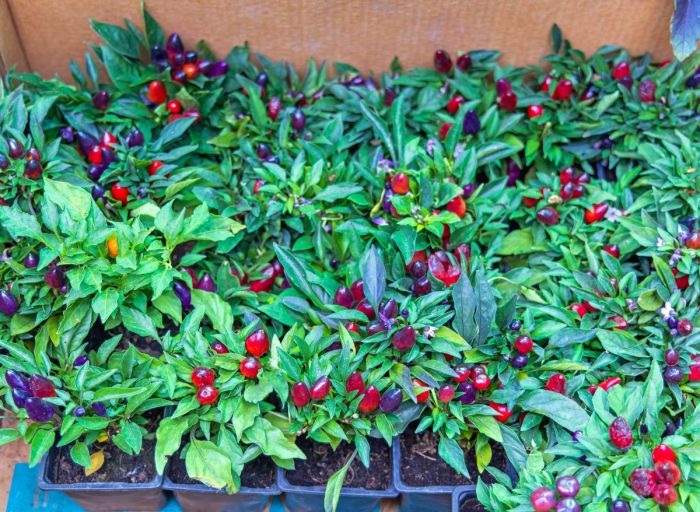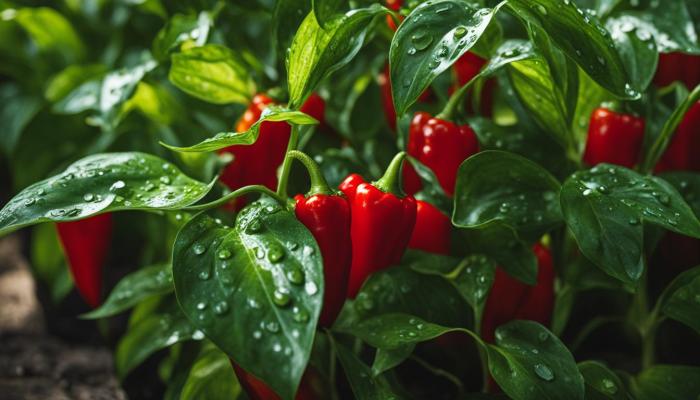How Much Should I Water My Pepper Plants?
Factors Influencing Pepper Plant Watering Needs
How much should i water my pepper plants – Proper watering is crucial for healthy pepper plant growth and yield. Several factors significantly influence how often and how much you should water your pepper plants. Understanding these factors allows for tailored watering practices, maximizing plant health and fruit production.
Environmental Factors and Pepper Plant Water Requirements
Sunlight intensity, temperature fluctuations, humidity levels, and wind exposure all impact a pepper plant’s water needs. Intense sunlight and high temperatures increase evaporation rates, necessitating more frequent watering. High winds also accelerate drying, while high humidity can reduce the need for watering. Conversely, cloudy, cool days will require less frequent watering.
Pepper Variety and Water Needs
Different pepper varieties have varying water requirements. Bell peppers, for example, generally require more consistent moisture than jalapeños, which tend to be more drought-tolerant. The specific needs of each variety should be considered when developing a watering schedule. Consult resources specific to the pepper variety you are growing for optimal guidance.
Soil Type and Watering Frequency
Soil type significantly affects watering frequency. Sandy soils drain quickly, requiring more frequent, but less voluminous, watering. Clay soils retain moisture longer, reducing the need for frequent watering but increasing the risk of overwatering. Well-draining soil is always preferable to prevent root rot.
Container Size and Material
The size and material of the container also influence watering needs. Larger containers retain moisture longer than smaller ones. Similarly, porous containers like terracotta pots dry out faster than plastic or ceramic pots. The table below summarizes these differences:
| Container Type | Size | Material | Watering Frequency |
|---|---|---|---|
| Small Plastic Pot | < 1 gallon | Plastic | Daily or every other day |
| Medium Terracotta Pot | 1-3 gallons | Terracotta | Every day or every other day, depending on weather |
| Large Plastic Pot | > 3 gallons | Plastic | Every 2-3 days |
| In-ground | N/A | Soil | Every 3-5 days, depending on weather and soil type |
Signs of Underwatering and Overwatering: How Much Should I Water My Pepper Plants

Source: plantsheaven.com
Recognizing the signs of both underwatering and overwatering is crucial for maintaining healthy pepper plants. Early detection allows for timely intervention, preventing significant damage.
Visual Signs of Underwatered Pepper Plants
Underwatered pepper plants exhibit several telltale signs. Wilting, drooping leaves, and dry, crumbly soil are common indicators. Leaves may also appear brittle and curl upwards. The plant may also show stunted growth.
Visual Signs of Overwatered Pepper Plants, How much should i water my pepper plants
Overwatering leads to different symptoms. Yellowing leaves, especially the lower ones, are a common sign. Soggy soil, a musty odor emanating from the soil, and stunted growth are also indicators. In severe cases, root rot can develop, leading to plant death.
Comparing Underwatering and Overwatering Symptoms
The following bullet points highlight the key differences between underwatering and overwatering symptoms:
- Underwatering: Wilting leaves, dry soil, brittle leaves, stunted growth.
- Overwatering: Yellowing leaves, soggy soil, musty odor, stunted growth, potential root rot.
Diagnosing Watering Problems
To diagnose watering issues, carefully examine the plant’s leaves, stems, and soil. Check for wilting, yellowing, or discoloration. Assess the soil moisture level by feeling the soil; if it’s dry, the plant needs water; if it’s consistently soggy, the plant is likely overwatered.
Proper Watering Techniques

Source: everythingbackyard.net
Employing the correct watering techniques ensures even moisture distribution, promoting healthy root development and preventing both underwatering and overwatering. Different methods have advantages and disadvantages depending on your setup and resources.
Methods for Watering Pepper Plants
Several methods effectively water pepper plants. Deep watering, where you thoroughly soak the soil until water drains from the bottom of the pot or into the surrounding soil, is highly recommended. Drip irrigation provides a consistent and efficient watering system. Hand watering allows for more control but requires careful attention to ensure even distribution.
Ensuring Even Water Distribution
To achieve even water distribution, water slowly and deeply. Allow the water to soak into the soil thoroughly. Avoid overhead watering, as this can lead to fungal diseases. For container plants, ensure adequate drainage holes to prevent waterlogging.
Watering pepper plants correctly is crucial for a bountiful harvest. The ideal amount depends on various factors, including soil type and weather conditions. To understand the general principles, it’s helpful to consult a guide on how much should I water a plant , as the fundamentals apply to peppers too. Remember to check soil moisture before watering; water deeply but infrequently, allowing the soil to dry slightly between waterings to avoid root rot in your pepper plants.
Comparison of Watering Methods
| Watering Method | Advantages | Disadvantages |
|---|---|---|
| Deep Watering | Simple, effective, encourages deep root growth | Can be time-consuming, may lead to runoff if not careful |
| Drip Irrigation | Efficient, consistent watering, reduces water waste | Requires initial investment, can be complex to set up |
| Hand Watering | Allows for close monitoring of soil moisture, flexible | Requires more time and attention, may lead to uneven watering if not careful |
Checking Soil Moisture with the Finger Test
The finger test is a simple method to check soil moisture. Follow these steps:
- Insert your index finger about an inch into the soil.
- If the soil feels dry, it’s time to water.
- If the soil feels slightly moist, wait a day or two before watering.
- If the soil feels wet or soggy, the plant is overwatered.
Watering Schedules and Adjustments
A consistent watering schedule is essential for healthy pepper plants, but it needs adjustments based on growth stage and weather conditions. The amount of water needed also varies with plant size and container size.
Sample Watering Schedule
This is a general guideline; adjust based on your specific environment and plant needs:
- Seedling Stage: Water frequently, keeping the soil consistently moist but not soggy.
- Vegetative Stage: Increase watering frequency as the plant grows, ensuring the soil remains moist.
- Fruiting Stage: Maintain consistent moisture, increasing watering during hot, dry periods.
Adjusting Watering Frequency Based on Weather
During hot, dry weather, increase watering frequency. During rainy periods, reduce watering or skip watering altogether if the soil is already moist. Monitor soil moisture regularly and adjust your schedule accordingly.
Determining the Appropriate Amount of Water
The amount of water needed depends on several factors, including pot size, soil type, weather, and plant size. Water until you see drainage from the bottom of the pot or until the top few inches of soil are thoroughly moistened. Avoid overwatering.
Troubleshooting Watering Issues
Despite best efforts, watering problems can occur. Recognizing common issues and implementing appropriate solutions is crucial for maintaining healthy pepper plants.
Common Watering Problems
Inconsistent watering, leading to alternating periods of drought stress and overwatering, is a common problem. Improper drainage, resulting in waterlogged soil and root rot, is another significant issue. Using the wrong type of container can also lead to watering problems.
Solutions for Correcting Watering Errors
If underwatered, water deeply and consistently. If overwatered, allow the soil to dry out partially before watering again. Improve drainage by using well-draining soil and containers with adequate drainage holes. For severely affected plants, repotting into fresh soil may be necessary.
Preventative Measures
Prevent watering problems by using well-draining soil, choosing appropriate containers, and monitoring soil moisture regularly. Employ consistent watering practices, avoiding both underwatering and overwatering. Consider using a moisture meter for added precision.
Maintaining Optimal Soil Moisture
Maintaining optimal soil moisture involves a balance between sufficient watering and preventing waterlogging. Regularly check soil moisture using the finger test or a moisture meter. Adjust watering frequency based on weather conditions and plant needs. Using mulch can help retain soil moisture and reduce the frequency of watering.
FAQ Explained
What type of water is best for pepper plants?
Use lukewarm water, avoiding cold water which can shock the roots. Rainwater is ideal, but if using tap water, allow it to sit for 24 hours to allow chlorine to dissipate.
How often should I check the soil moisture?
Check the soil moisture daily, especially during hot, dry weather. Use the finger test (inserting your finger a couple of inches into the soil) to determine if watering is needed.
My pepper plants have yellowing leaves. Is it overwatering or underwatering?
Yellowing leaves can indicate both overwatering (often accompanied by soggy soil and root rot) or underwatering (leaves may also wilt). Check the soil moisture; if it’s soggy, it’s likely overwatering; if it’s dry, it’s likely underwatering.
Can I use fertilizer with my watering?
Yes, but use a balanced, water-soluble fertilizer diluted to the recommended strength. Avoid over-fertilizing, as this can damage the plants.





















